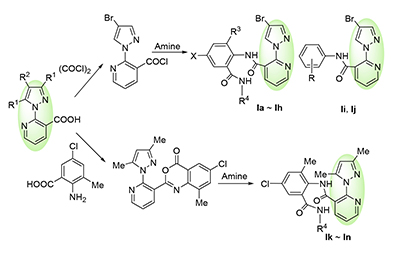| [1] Selby, T. P.; Lahm, G. P.; Senvenson, T. M. Pest Manage. Sci. 2017, 73, 658.
[2] Lahm, G. P.; Cordova, D.; Barry, J. D. Bioorg. Med. Chem. 2009, 17, 4127.
[3] Tohnishi, M.; Nakao, H.; Furuya, T.; Seo, A.; Kodama, H.; Tsubata, K.; Fujioka, S.; Kodama, H.; Hirooka, T.; Nishimatsu, T. J. Pestic. Sci. 2005, 30, 354.
[4] Chai, B.; Peng Y.; Li, H.; Zhang, H.; Liu, C. Agrochemicals 2009, 48, 13(in Chinese). (柴宝山, 彭永武, 李慧超, 张弘, 刘长令, 农药, 2009, 48, 13.)
[5] Lahm, G. P.; Selby, T. P.; Freudenberger, J. H.; Stevenson, T. M.; Myers, B. J.; Seburyamo, G.; Smith, B. K.; Flexner, L.; Clark, C. E.; Cordova, D. Bioorg. Med. Chem. Lett. 2005, 15, 4898.
[6] Dong, W.; Xu, J.; Xiong, L.; Liu, X.; Li, Z. Chin. J. Chem. 2009, 27, 579.
[7] Sun, N.; Shen, Z.; Zhai, Z.; Han, L.; Weng, J.; Tan, C.; Liu, X. Chin. J. Org. Chem. 2017, 37, 2705(in Chinese). (孙娜波, 沈钟华, 翟志文, 韩亮, 翁建全, 谭成侠, 刘幸海, 有机化学, 2017, 37, 2705.)
[8] Lamberth, C.; Dinges, J. In Bioactive Heterocyclic Compound Classes——Agrochemicals, Eds.:Lamberth, C.; Dinges, J., Wiley- VCH, Weinheim, 2012, pp. 3~20.
[9] Liu, X.-H.; Fang, Y.-M.; Xie, F.; Zhang, R.-R.; Shen, Z.-H.; Tan, C.-X.; Weng, J.-Q.; Xu, T.-M.; Huang, H.-Y. Pest Manage. Sci. 2017, 73, 1900.
[10] Wang, B.-L.; Zhu, H.-W.; Ma, Y.; Xiong, L.-X.; Li, Y.-Q.; Zhao, Y.; Zhang, J.-F.; Chen, Y.-W.; Zhou, S.; Li, Z.-M. J. Agric. Food Chem. 2013, 61, 5483.
[11] Zhang, J.-F.; Xu, J.-Y.; Wang, B.-L.; Li, Y.-X.; Xiong, L.-X.; Li, Y.-Q.; Ma, Y.; Li, Z.-M. J. Agric. Food Chem. 2012, 60, 7565.
[12] Wang, B.; Ma, Y.; Xiong, L.; Li, Z. Chin. J. Chem. 2012, 30, 815.
[13] Wang, B.-L.; Zhu, H.-W.; Li, Z.-M.; Wang, L.-Z.; Zhang, X.; Xiong, L.-X.; Song, H.-B. Pest Manage. Sci. 2018, 74, 726.
[14] Yan, T.; Yu, S.; Liu, P.; Liu, Z.; Wang, B.; Xiong, L.; Li, Z. Chin. J. Chem. 2012, 30, 919.
[15] Clark, D. A.; Lahm, G. P.; Smith, B. K.; Barry, J. D.; Clagg, D. G. Bioorg. Med. Chem. 2008, 16, 3163.
[16] Cheng, L.; Zhang, R.-R.; Han, L.; Tan, C.-X.; Weng, J.-Q.; Xu, T.-M.; Liu, X.-H. J. Heterocycl. Chem. 2018, 55, 2585.
[17] Shi, J.-J.; Ren, G.-H.; Wu, N.-J.; Weng, J.-Q.; Xu, T.-M.; Liu, X.-H.; Tan, C.-X. Chin. Chem. Lett. 2017, 28, 1727.
[18] Dong, W.-L.; Liu, X.-H.; Xu, J.-Y.; Li, Z.-M. J. Chem. Res. 2008, 9, 530.
[19] Wu, C.-C.; Wang, B.-L.; Liu, J.-B.; Wei, W.; Li, Y.-X.; Liu, Y.; Chen, M.-G.; Xiong, L.-X.; Yang, N.; Li, Z.-M. Chin. Chem. Lett. 2017, 28, 1248. |
